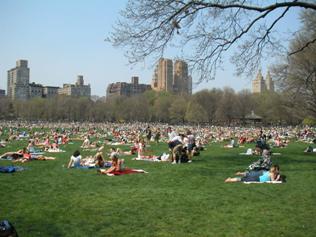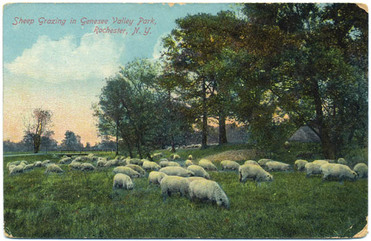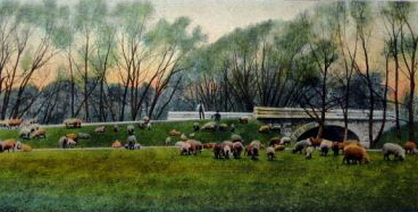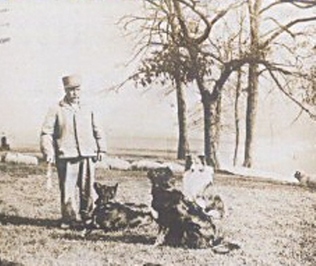
|

|
|
-- Shepherds of Manhattan --
In 1858 a
competition was held for a plan to develop a large
public park in New York City. The winning designers,
Calvert Vaux and Frederick Law Olmsted, envisioned a
pastoral atmosphere, elegant and peaceful, carefully
designed to look natural. Grazing sheep, tended by a
shepherd and dog, were part of that vision. Olmsted
preferred that the grass be clipped by sheep,
considering the results superior in appearance to those
obtained by use of mechanical mowers, and sheep provided
fertilizer as well. By 1863 a flock of Southdowns was
established in the park.
Other big city parks, a number of them also designed by Olmsted, followed a similar pattern. Prospect Park in Brooklyn, Genesee Valley Park in Rochester, Franklin Park in Boston, Druid Hill Park in Baltimore, Washington Park in Chicago, and more, were home to flocks of sheep.
Peaceful scene for park-goers in
1916 -- a flock grazes in a city park,
To house the Central Park
flock, a fanciful sheepfold was built in 1870, with
quarters for the shepherd and his family as well. Over
the years, as traffic increased and changed from carriages to cars, the sheep were escorted by their
shepherd across the street to their grazing grounds and
back again in the evening. For many years that shepherd
was James Conway, a native of Ireland. He became the
park shepherd in 1876 after having already worked for
the city parks department for several years. He
remained on the job until his retirement in 1913.
For a short period after that, Patrick Keenan was delegated to look after the sheep. Keenan was the keeper of the monkeys at the zoo and was displeased about the addition of shepherding to his duties, so he was soon succeeded by Frank Hoey, who remained the shepherd for the next 20 years.
The park sheepdogs were usually collies. In 1878 the kennel columnist of the magazine Forest and Stream wrote:
The working of tending and driving sheep by a
well bred collie can be witnessed almost every day
at the Central Park in this city. The dog,
Scot, a blue mottled, is the property of Mr. W. F.
Morgan, and was, if we mistake not, bred by Mr. John
Hobart Warren, of Troy, N.Y., who imported a number
of fine collies from the Queen’s kennels at
Balmoral. When Scot had attained his growth he was,
at our suggestion and through the kindness of
Mr. Conklin, placed with the sheep in the Park, where
he soon developed the characteristic sagacity
of his race. Only a few days since while we were
riding
past, the keeper, at our request, called to
Scot, ‘Go round them, Scot,’ and in two minutes the
whole flock was in a compact mass.
The story is told of the determination of one of Central
Park’s collies, Shep, to remain on duty when, after many
years of service with the flock, an attempt was made to
retire him. The aging sheepdog was sent to a farm in
Putnam County, north of the city. Unhappy about the
change, he undertook a journey of 50 miles and found his
way back to the Central Park fold. A successor, Jack,
was donated by financier and noted show Collie breeder
J.P. Morgan in 1903, and continued to work until James
Conway’s retirement. Others breeds sometimes were used
– in Central Park, Jack’s successor was an Airedale, and
in subsequent years, in addition to several collies, an
Old English Sheepdog helped tend the Central Park sheep
in 1920, while in 1931 a German Shepherd Dog was on the
job.
A gift
from J. P. Morgan, Jack worked in Central Park
with shepherd James Conway
Sheep in Franklin Park, Boston –
the shepherd and his dog can be seen In Franklin Park in Boston, the sheep were taken from their quarters in Franklin Field to graze in the area of the golf links, guided on their way by shepherd James Sweeney and his dogs. As related in a 1903 account: Almost before the dew has vanished from the fresh, green grass, the entire flock begins the procession from Franklin field to the park. Through the streets the dogs keep a watchful eye out for stragglers and “bolters” and do not relax their vigilance for an instant until the tiniest little lamb has been driven onto the golf course. It requires a good deal of judgment, even for a human being, to keep the sheep off the private lawns and flower beds on the streets through which the flock passes on its way from field to the park, but the dogs seem to know as well as their master what is expected of them.
The dogs and flock of Franklin Park, Boston, 1903 A Boston Globe reporter wrote in 1910 about the flock of 250: It is a refreshing, restful sight to see, within the confines of a big city, the pastoral picture of a flock of sheep grazing, attended by the shepherd and his dogs. It is as if a bit of peaceful country life had been infused into the hustle of the busy metropolis. James Sweeney’s dogs then were Prince and Clyde. An older dog, retired from active herding, served as the night watch for the flock at the fold.
The intelligence of Scotch collies is proverbial. A whistle from
the shepherd and an indication with
his stick in the direction of some stragglers from the flock and
the dogs are off like a flash to bring back the wanderers. Usually, however, even this is not necessary,
as the dogs patrol sentry-like
around the sheep or post themselves in an advantageous position
where they can command a good
view of the whole flock, and while they do not pack the sheep
close together unless ordered to do so,
they nevertheless do not allow stragglers to wander very far. While contributing a picturesque element for the viewing pleasure of park visitors, the sheep were expected to fulfill practical requirements as well, and were handled like any other commercial flock. Lambs were born, sheep were shorn, there were yearly sales of wool, lambs and grown sheep. In Central Park the sheep were Southdowns at first, then later on the flock was changed to horned Dorsets. Franklin Park had Shropshires, as did Fairmount Park in Philadelphia. Baltimore’s Druid Hill Park had a fine flock of Southdowns. The sheep were quite tame and often were petted by park-goers. Interaction with the public wasn’t always positive, however. There were incidents when sheep became ill from eating trash left by picnickers. In Prospect Park a pushy ewe was known to raid baby carriages, even knocking them over, for the food she thought she might find there.
Washington Park, Chicago, Illinois, 1917
Baltimore’s Druid Hill
Park had two flocks, with a shepherd and dogs for
each. Sheep were first installed in Druid Hill Park in
1869. In 1900 there were plans to sell the sheep, but
the public wanted them to stay, and sheep were grazed in
the park for another 40 years
Shepherd John Burnett tending the flock in 1908 in Druid Hill Park, Baltimore, Maryland
Druid Hill Park, Baltimore, 1910
Below the Mansion House, Druid Hill Park, 1914 When Genessee Valley Park in Rochester, NY, was established, designer Frederick Law Olmsted suggested that a flock of sheep be acquired for the park. For many years beginning in 1892, sheep kept the grass trimmed and enhanced the pastoral scene.
|
|
|
|
|
Genessee Valley Park in 1905 | Two collies move the flock through Genessee Valley |
|
In a rural setting, but performing a similar function to the park sheep, were the flocks used to graze the grounds on the estates of the wealthy. While there were plenty of regular farm sheep, of course, there were also flocks whose purpose was to keep the lawns around the mansion trimmed and, as was the case in the parks, add a picturesque element. Both the designers of many of the city parks and the wealthy owners of eastern estates admired the scenery of English estates and private parks, and sheep were an element of that atmosphere. Sheep on two of the Rockefeller estates were tended by two brothers from England – Cecil Fawkes at the Pocantico Hills estate of John D. Rockefeller, and Archie Fawkes at the Tarrytown estate of William Rockefeller. Collies and Old English Sheepdogs helped the brothers in their tasks. John D. Rockefeller did a cost comparison of the sheep vs. motorized mowing machines, and came down in favor of the sheep. By the 1930s, the day of the park sheep was almost over. In New York City, Parks Commissioner Robert Moses had no place for the sheep in his scheme of things. The flock was said to have deteriorated. There was a concern that sheep would be in danger of being stolen and eaten by the poor and homeless of the Great Depression. Moses wanted to turn the sheepfold into a moderately-priced restaurant. The Dorsets of Central Park were sent to join the Southdowns in Prospect Park. Frank Hoey, the last shepherd in Manhattan, was transferred to the Central Park zoo, and retired the next year. Eventually all the sheep were removed from Prospect Park as well. The fanciful sheepfold in Central Park became the famous Tavern On The Green Restaurant. The name of the Sheep Meadow remained as a testimony to the long presence of the Central Park flock. In 1979, sheep returned briefly to the Sheep Meadow, when as a publicity event in connection with the launch of a book called The Last Shepherds, a small herding trial was held. Border Collies demonstrated their prowess, and for a brief time, bleats and baas were heard once again on the Sheep Meadow. Today, a few sheep can still be found in Central Park -- they no longer roam their old grazing grounds, but reside in the Tisch Children’s Zoo on the eastern side of the park. | |
|
|
 |
The Sheep Meadow, 1930 |
The Sheep Meadow, 2004 |
The Central Park
sheepfold in recent times – for many years it has been the Tavern on the
Green restaurant, * * * * * * * * * *
City park flocks were often featured on
postcards. | |
|
|
 |
Elizabeth Park, Hartford, Connecticut, 1906 |
Genesee Valley Park, Rochester, New York, 1909 |
|
|
 |
Keney Park, Hartford, Connecticut, c1910-1920 |
Roger Williams Park, Providence, Rhode Island, 1905 |
|
|
 |
Theodore Wirth Regional Park, Minneapolis, Minnesota, 1928 |
Prospect Park, Brooklyn, NY, 1907 |
|
My thanks to Penny Tose for her assistance. | |